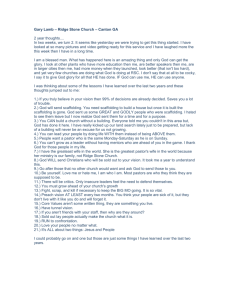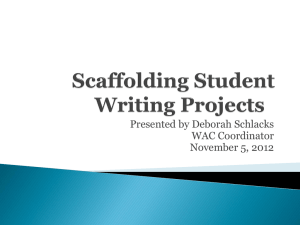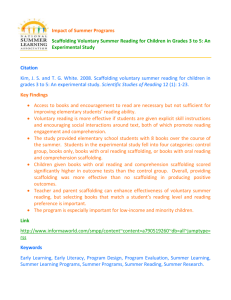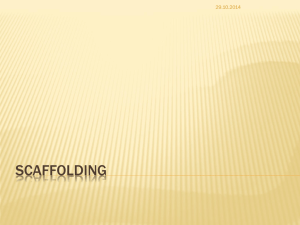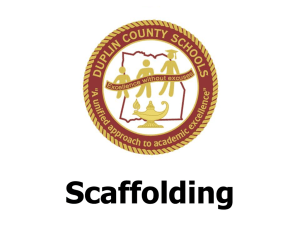Session 2
advertisement
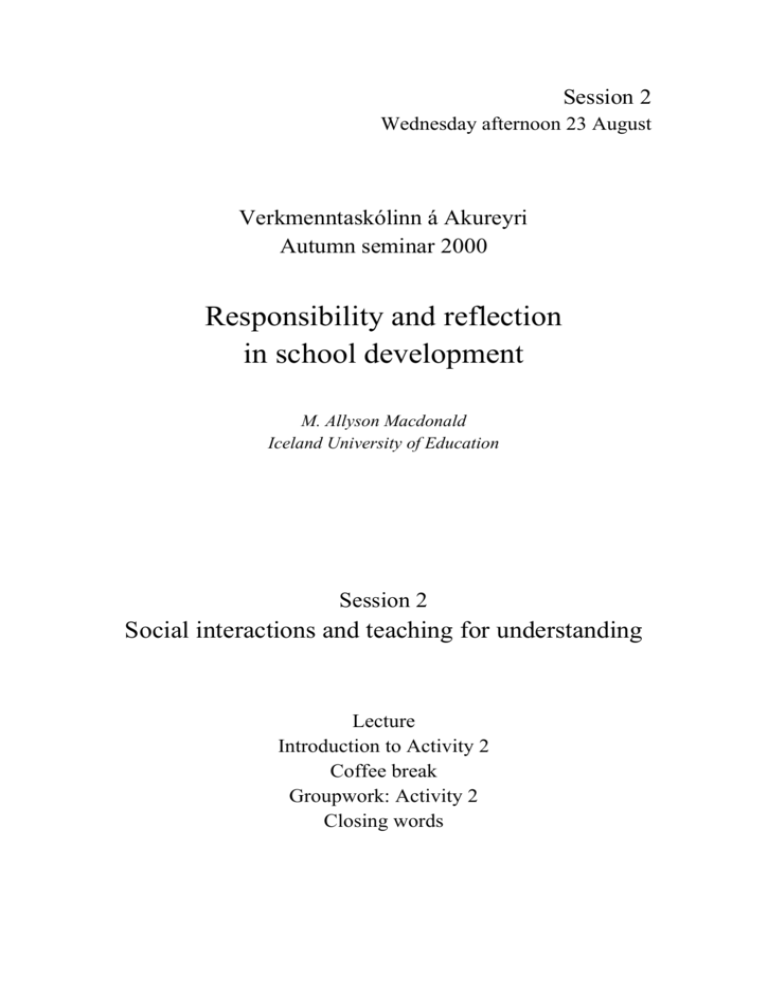
Session 2 Wednesday afternoon 23 August Verkmenntaskólinn á Akureyri Autumn seminar 2000 Responsibility and reflection in school development M. Allyson Macdonald Iceland University of Education Session 2 Social interactions and teaching for understanding Lecture Introduction to Activity 2 Coffee break Groupwork: Activity 2 Closing words Social interactions and learning What I would like to talk about in this session is constructivist-compatible teaching and its effect on student learning. I would also like to look briefly at school cultures and how they are reflected in teaching practices. The rationale behind the discussion is that teaching is a means to an end, not an end in itself, and that the teaching practices which teachers adopt have an effect on the manner and extent to which students learn. Research from the last few decades has shown us that theories of the way in which students learn give us guidelines on how we should teach, and why. The common thread through the discussion will be the function of social interactions in teaching, learning and the work of the school. What are social interactions? What is constructivism? For our purposes, we can distinguish between interactions, which are built on communication, coordination, coooperation, and collaboration. Communication – the sending and receiving of messages Coordination – communication in order to facilitate the organisation of an activity Cooperation – Collaboration – coordination of activities where groups coordination of activities where groups work on the (?same or) different activities work on the same or different activities in for different purposes order to achieve the same purpose Constructivism has been discussed by such educational theorists as Dewey, Piaget and Vygotsky. In particular, Vygotsky has spoken of social constructivism and the importance of social interactions in the construction of knowledge and understanding. Some teachers believe that knowledge is transmitted directly; it is simply communicated from text or teacher to student. Others believe that knowledge is constructed through cooperation and collaboration, with knowledge networks being structured around powerful ideas, and prior knowledge having an important role. For them knowledge is actively constructed through conceptual change and learning, and is best situated in natural settings with authentic tasks. We can compare the two views (Good and Brophy 2000, p. 421) 1 Transmission view Knowledge is a fixed body of information to be transferred from text or teacher to student Texts and teachers are considered authorities Teachers manage learning by providing information and coordinating activities and assignments Teachers explain, check for understanding and correct for student responses Students memorize or replicate what has been explained or modelled Discussion emphasises drill and recitation, focussing on correct answers Teachings is built on replication and practice; focus on knowledge Students work alone Social construction view Knowledge develops through interpretations co-constructed through discussion Everyone has expertise to contribute; one needs arguments and evidence Teachers and students share responsibility for learning Teachers act as discussion leaders promoting dialogue, questioning and seeking clarification Students try to make sense of new input by relating it to prior knowledge and taking part in dialogues Discussion is focussed on eliciting students’ thinking, and making networks of connected knowledge Teachers encourage applications to authentic issues and higher order thinking Students collaborate by working as a learning community The term zone of proximal development is the gap between what students can already do on their own and what they are capable of doing with help. Scaffolding is the term given to the strategies which a teacher might use to bridge the gap (Dodge 1998). Key features of teaching within this framework are: In constructivist teaching it is crucial to develop student interest in the task to be performed (cf. motivation). The responsibilities for a task itself and for the management of learning are gradually transferred by the teacher to the learner. Explanations and modelling by the teacher are important but also plenty of opportunities must be provided for students to process the content actively and construct their understanding. Questions are used to stimulate students to process and reflect on the content, recognize relationships and think critically about the ideas. Skills are taught within the context of applying them, not practised in isolation. The interactive use of language is absolutely crucial in constructivist practice. Language gives us the tools to think and to develop, to work with concepts 2 and to develop new ones. Interactions with peers or experts are important for learning. If the exercise is based on reading of texts then students must be taught to interact with the ext, to work with it, to question it, to move back and forth within it. School culture, teacher pedagogy and constructivism A recent study (Becker and Riel 1999) considered relationships between school culture, teaching roles and constructivist compatible activities. Teacher roles were considered in terms of the frequency and nature of interactions with other teachers in their school and beyond their school. The scale of interactions ranged from the “private” teacher who had few interactions and taught behind a closed door to those termed “public” teachers who engaged in a variety of interactions and who had an open door policy. School culture was determined by the level of gaol consensus, the nature of staff development, public recognition of teacher accomplishment, constructive criticism among peers and a sense of teachers being part of a collaborative community of professionals. The culture extremes were called the “bureaucratic” and the “professional” culture. Teacher roles were found to correlate with the extent to which they used constructivist activities in their classrooms. Movement towards a professional culture is not necessarily a strong predictor of constructivist activities, but if there is strong commitment to professional participation (the community) then there is relationship with the use of constructivist activities. Of course the chicken and egg question now arises. Does the adoption of constructivist teaching practices lead to the development of a professional community, or is the reverse true? Lee, Smith and Croninger (1996) have shown that restructuring high schools can improve student achievement. It is clear that teachers who take professional leadership roles are also the teachers who are most likely to believe that students should take active leadership roles in constructing their own knowledge (Becker and Riel 1999). “Teachers who are isolated from their peers, engage in teaching in which students work alone. Teachers who work in collaborative settings, create the same settings for their students.” What is interesting about this and the discussion this morning, about teaching as a profession. In a bureaucratic culture it is the work of the administrators to assure quality of the teaching staff. In a professional culture, it is the responsibility of the community. “What happens in any single classroom is the concern of all teachers as their success is only possible through collective, interdependent effort” (Becker and Riel 1999, p. 4). 3 What is also clear is that depending on the teacher’s beliefs and practices, students will either have a very active or passive role. Working in groups to ensure cooperative learning All of us have had the experience of working in groups which don’t work. We have had students who have complained about having to work in a group. We know that some students use group work as an opportunity to do work. Some of us however have had the experience of working in a group which really does work, where each member does something, where the purpose of working in the group is achieved. Assigning students to group work should never really be easier than going into transmission mode and giving a lecture. The lecture will require preparation before and time spent on delivery. Group work can often require considerable preparation, may require constant feedback and support (scaffolding) and its evaluation will require an effort by both students and teachers. Research has shown that in very diverse school settings and across a wide range of content areas that students who complete cooperative learning tasks tend to have higher academic scores, higher self-esteem, greater numbers of positive social skills, fewer stereotypes and greater comprehensions of the content and skills they are studying (Stahl 1994). Research also shows that students in the cooperative learning environment have a higher degree of purposeful activity, and task-related interactions. Successful groups promote student interactions that increase cognitive processing, higher order thinking and integration of information (Alderman 1999, p. 202) What are key factors in making group work successful? Slavin (1988) says that research evidence shows that cooperative learning strategies are not equally effective, though most positively affect self-esteem, intergroup relations, and the ability to work with others. To produce achievement gains, these methods must include both a group goal and individual accountability. Let us look briefly at some of these points (taken in part from Stahl 1994 and Gross Davis 1999): Group goals and learning objectives: Students must accept that all group members need to obtain information, understand it and develop skills. Teachers should make very clear the objectives for the group work and work with students such that they should perceive their objectives as their own. Structure and management of opportunity: Students must have access to the necessary information, the opportunities to access it and sufficient time. Many of the positive benefits of cooperative learning only emerge after students have spent four or 4 more weeks in the same group. Students also need time to learn some of the interactive skills which are called for in group work, such as leadership, conflict management, constructive criticism, negotiation and compromise. Teachers must work with students to build up these skills. Individual accountability: Teachers must structure learning tasks so that students come to believe that they sink or swim together. At the same time each students must be held individually accountable for doing his or her share of the work. This can be done through work reports, meetings with teachers and through tests. Group reflection: Students should consider whether they achieved their goals, how they helped each other and what they need to do next time to make the work more successful. Teachers should plan for this reflection time. ___________________ Different group techniques have been given different names and are used for different purposes. It is important to remember that if we are to speak of collaborative learning then students are working together, towards the same goal Here we will introduce a few techniques for working in groups (from Hassard 1990, and Benedict 1991): STAD (Student Teams Achievement Divisions): Kennsla, námsefni – kennari stýrir ferli og leggur inn efni Hópvinna til að fara yfir og læra efni Próf – hver nemandi er með viðmið Framför miðað við viðmið er reiknuð út og lagt saman Hópeinkunn byggð á framför einstaklinga Jigsaw II: Námsgögn undirbúin eða kynnt Námshópar taka til starfa og verkefni skipt á sérfræðingar Nemendur fara í sérfræðihópa og kynna sér efni Nemendur fara aftur í námshópar og kynni efni Námshópar taka saman sérfræðiþekkingu Próf Co-op co-op: Umræður, nemendur varpa fram hugmyndum Hópar velja viðfangsefni Verkaskipting innan hópa og framkvæmd Hópvinna og skýrslugerð Munnleg framsetning Mat (próf) á viðfangsefninu í heildinni 5 Group investigation: Kennari kynnir viðfangsefni og það skipt niður Hópar stofnaðir og viðfangsefni valin Hópar skipuleggja námsleiðir með kennaranum Framkvæmd, nemendur safna efni og kynni þetta fyrir hvor öðru Nemendur greina, meta og taka saman efni Munnleg eða skrifleg framsetning Mat (próf) Other social interactions Short social interactions: Felder (1992) has given some ideas for short interactions which can make a difference to teaching and learning. He suggests some short in-class group problem-solving. By this he means that instead of the usual question and answer sessions, he occasionally assigns a task and give the class a few minutes to work on it in groups of three to five at their seats. Examples include Sketch a plot of what the problem solution should look like. Give several reasons why you might need or want to know the solution. What's the next step? What's wrong with what I just wrote? How could I check this solution? What question do you have about what we just did? He also suggests what he calls in-class reflection and question generation or the oneminute paper which is an in-class assignment in which students nominate the most important and/or the most confusing points in the lecture, section or course just concluded. About two minutes from the end of a class, the students, working individually or in small groups, are asked to write down and turn in anonymous responses to one or two of the following questions: What are the two most important points brought out in class today (this week, in the chapter we just finished covering)? What were the two muddiest points in today's class (this week's classes, this section of the course)? What would make this material clearer to you? Make up a question about an everyday phenomenon that could be answered using material presented in class today (this week). One or two of your questions may show up on the next test. Study teams: Gross Davis (1999) has suggested that teachers can encourage their students to form study teams based on some of the same principles that are used in group learning organised by teachers. Teachers can explain how such teams might work and what their individual responsibilities might be. Groups should be three to six students selected by themselves, unless the teacher can assist students in 6 coordinating study times. Teachers can use a portion of class session for organising the teams. ____________________ We move now to the second set of activities . 7 Heimildaskrá Alderman, M.K.. 1999. Motivation for achievement. Possibilities for teaching and learning. Mahwah, New Jersey, Lawrence Erlbaum Associates. Becker, H.J. and Riel, M.M. 1999. Teacher professionalism and the emergence of constructivist-compatible pedagogies. Revised version of a paper presented at the 1999 meeting of the American Educational Research Association. http://www.crito.uci.edu/tlc/findings/special_report2/abstract.htm Benedict, F. (Ed.). 1991. Environmental Education for Our Common Future. Norwegian University Press. Kafli 7, 18 og 25. Dodge, B. 1998. Schools, Skills and Scaffolding on the Web. Ed Tech Department, San Diego State University. http://edweb.sdsu.edu/people/bdodge/scaffolding.html Felder, R. 1992 "How About a Quick One?" Chem. Engr. Education, 26(1), 18-19 (Winter 1992). http://www2.ncsu.edu/unity/lockers/users/f/felder/public/Columns/Quickone.html Gross Davis, B. 1999. Collaborative learning: group work and study teams. Tools for teaching. http://uga.berkeley.edu/sled/bgd/collaborative.html Hassard, J. 1990. Cooperating Classroom. Science Scope, March 1990, bls. 36-39, 45. Stahl, R.J. 1994. The essential elements of cooperative learning int eh the classroom. ERIC digest ED370881, ERIC Clearinghouse for Social Studies/Social Science Education, Bloomington, Indiana. Lee, V.E., Smith, J.B. and Croninger, R.G. 1996 Restructuring high schools can improve student achievement. http://www.wcer.wisc.edu/Publications/WCER_Highlights/Vol.8_No.1_Spring_1996/ Restructuring_high_schools.html Pitt, T.J. 2000. Instructor’s manual/Test Bank. To accompany Good and Brophy, Looking in Classrooms, Eighth Edition. New York. Longman. 8 Activity 2 Teaching for understanding Purpose: These activities are designed to further discussion on key concepts in social constructivism and teaching for understanding. They are also intended as an opportunity to apply these concepts to teaching plans and activities. Background: By understanding we mean that students learn not only individual elements in a network of content, but that they also can explain the connections between them, they can explain the content in their own words and they can access and use it in appropriate applications and situations. Key ideas in teaching for understanding are: a. Teachers accept that knowledge is constructed, not transmitted. b. Knowledge networks of students are structured around powerful ideas. c. Prior knowledge of students plays an important role in their acquisition of new concepts. d. Students need to restructure knowledge and undergo conceptual change in developing new knowledge. e. Active construction takes place best when two or more individuals engage in sustained discourse (dialogue) about a topic. f. Learning and tasks should be presented and assessed in authentic situations. g. Teachers use modelling and scaffolding to transfer the responsibility for managing learning to the learner. Activities: Form groups of about 10 teachers. Pairs within each group should undertake at least one of the following activities. At least three different activities should be presented within each group to other group members and discussed by the group as a whole. 2.1 Powerful ideas: Identify a unit that you teach. Identify a limited set of powerful ideas around which the content might be organized. How do you know they are powerful? Are they powerful to students? How could you find out? Outline a teaching plan for the unit where you would make use of the powerful ideas. How would you provide opportunities for students to restructure their knowledge? (based on Pitt 2000, p. 113) 2.2 Extending skills and understanding: Select certain concepts or skills that you would like students to understand well. Develop 6-10 ideas for using smallgroup activities to extend these certain concepts or skills to higher levels of thinking or the application stage. Share these ideas with another pair, discuss 9 and revise them, and then present them to the larger group. (based on Pitt 2000, p. 113) 2.3 Scaffolding and modelling: Choose a teaching situation in which you are able to use the concepts of modelling and scaffolding. The scaffolding is there to aid the completion of a task and like real scaffolding it is eventually removed. Scaffolding can involve modelling a performance while thinking out loud, pairing advanced learners with developing ones, providing prompts, links, guides and structures and most important, fading when appropriate. How would you start? How would you structure the lesson or series of lessons? What sort of assessment would be appropriate? What would be the role of the students? Have you done this before? When? Did it work? 2.4 Authentic assessment, reporting and reflection: If one changes the ways in which one teaches, then it follows that assessment techniques must change accordingly. Discuss ways in which you could change these. What is meant by “authentic assessment” ? What is performance-based assessment? Where would you begin? What role would students have to play? Would the way in which grades are reported to students have to change? If so, how? Do the assessment techniques give the student a chance to reflect on what he has done in a constructive manner? 2.5 Replacing direct instruction: Think over some of the lectures that you give in your classes. Develop 6-10 small-group activities that might be used to replace some of them and involve students in problem-solving or higher level thinking. Share these ideas with another pair, discuss and revise them, and then present them to the larger group. (based on Pitt 2000, p. 113) 2.6 Motivation and interactions: What aspects of optimum motivation are supported by students constructing knowledge, and vice versa? Are there any contradictions and if so, what? 2.7 Open option: Choose an aspect of Session 2 which has aroused your interest in ways not suggested above. Discuss them with your partner and consider ways in which they might influence your teaching practices. Also consider what influence they might have on the school as a whole. 10
